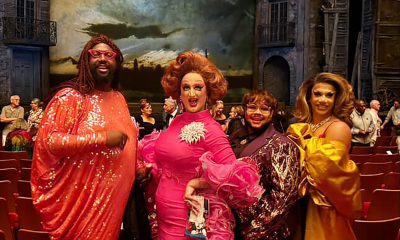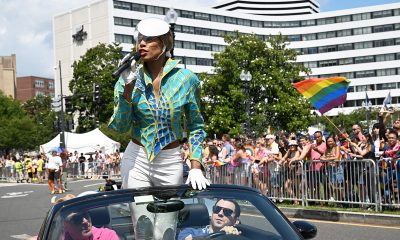National
White House holds LGBT health summit
Officials hail LGBT progress at Philadelphia conference
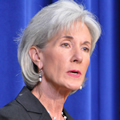
PHILADELPHIA — The White House heard the concerns of LGBT people here during the first of a series of conferences aimed at allowing the Obama administration to engage directly with the LGBT community and highlight its achievements.
More than 300 people from 22 states attended the conference, which was focused on LGBT health, on Thursday in the Dorrance H. Hamilton Building at Thomas Jefferson University.
Obama administration officials touted their work over the past three years on health and LGBT issues. Conference participants asked questions of officials in a town-hall style format — many focused on transgender inclusion of the administration’s LGBT work — and participated in workshops on issues such as LGBT aging, youth and transgender health as well as the health care reform law and engagement opportunities with the administration.
Secretary of Health & Human Services Kathleen Sebelius delivered the keynote speech and emphasized the purpose of the conferences was to allow the Obama administration to have greater engagement with the LGBT community.
“The goal of these conferences is to talk about some of the work that we’re doing that might be of interest to you in health, but it’s also a real opportunity … to listen, to have you share your ideas and your challenges and your struggles with us because that really helps us inform our policy each and every day,” Sebelius said.
The secretary invoked President Obama’s State of the Union address, recalling his emphasis on “fairness” as a core American value, and said this sense of fairness applies to LGBT people.
“We need to have an America that values everyone and has the same set of values and same set of rules for everyone,” Sebelius said. “And that belief means ensuring that LGBT Americans have the same protections and opportunities as their neighbors, as their colleagues, as their family members.”
Sebelius also emphasized the importance of the health care reform law. Among the LGBT-specific areas the secretary trumpeted was preventing insurers from discriminating against someone based on LGBT status, initiating data collection efforts on LGBT health and expanding HealthCare.gov to facilitate searches for health insurance plans covering same-sex partners.
The secretary also touted the insurance exchanges aimed at lowering costs to make health care more affordable.
“Every American in 2014 will have access to an insurance exchange, either run by the state or run by the federal government,” she said. “The only thing that the state can do is opt out of running it themselves, but believe me, right behind them, is us.”
Sebelius also addressed the administration’s effort to combat HIV/AIDS through the National AIDS Strategy, noting that half of all black gay men in urban areas are living with the disease.
“The result is more momentum behind domestic HIV efforts today than we’ve had for nearly a decade, and we’re only just beginning,” Sebelius said. “We think we have an opportunity … to look at a generation that will be HIV free.”
On Monday, Obama made public his budget request for fiscal year 2013, which includes an increase in funding for domestic HIV/AIDS programs, but flat-lined research programs and cut the President’s Emergency Plan for AIDS Relief, which is aimed at fighting AIDS overseas.
No mention was made about progress in research efforts to lift the Food & Drug Administration’s ban prohibiting gay and bisexual men from donating blood. HHS told members of Congress in July it was studying four areas to determine whether it could end the ban.
John Berry, director of the Office of Personnel Management and the most senior openly gay official in the Obama administration, delivered opening remarks at the event that catalogued Obama’s LGBT achievements, including repeal of “Don’t Ask, Don’t Tell” and discontinuation of the defense of Section 3 of the Defense of Marriage Act in court.
“I grew up in a time when it was OK to discriminate based on sexual orientation, when I could be kept from a loved one’s hospital bed, when I couldn’t serve the country I loved just because of who I loved,” Berry said. “Many of us in this room grew up in the midst of that fear and hostility, but thankfully the tide is turning.”
Berry cited the legal briefs the Obama administration has filed in cases against DOMA: both in Golinski v. United States and Windsor v. United States.
“I encourage you, if you’ve never read a legal brief, pick this one up,” Berry said. “It explains why discrimination based on sexual orientation is entitled to heightened constitutional scrutiny, and that is based upon the history that we have lived through and why they conclude — the president and the Justice Department — that Section 3 fails that scrutiny.”
Outstanding work on LGBT issues that the president wants to see accomplished, Berry said, includes removing DOMA from the books and passage of the Employment Non-Discrimination Act.
After his speech, Berry told the Washington Blade that he couldn’t “go into any specifics” about forthcoming LGBT-related policy changes.
“The beauty of having over 200 LGBT appointees embedded across our government is that every day they’re making changes in regulations and forms and laws and working in policies that are making the future,” Berry said.
Berry deferred questions to the White House on whether the new initiatives would include an executive order requiring federal contractors to have LGBT-inclusive non-discrimination policies.
The conference also featured a panel of three HHS officials: Kathy Greenlee, assistant secretary for aging; Howard Koh, assistant secretary of health; and Ken Choe, deputy general counsel. Greenlee and Choe are openly gay.
During his remarks on the panel, Greenlee said she “must crow about” how HHS recognizes diversity within the LGBT community as it works on related issues.
“The people at HHS are sophisticated enough and committed enough to understand that LGBT is not a word and that each of those letters represents a different community,” Greenlee said. “As we do the analysis of our work, there are times that we stop and say, ‘What are we doing for the transgender community? Do we have anything for bisexuals? And lesbian and gay health are different issues.”
According to the White House, later conferences planned in other places throughout the country will focus on topics including — but not limited to — housing and homelessness, safe schools and communities, and HIV/AIDS prevention. An informed source said the next conference will take place March 9 in Detroit and will focus on LGBT homelessness.
Kellan Baker, a health policy analyst for the Center for American Progress’ LGBT research and communications project, attended the conference.
“It’s amazing that LGBT health is the first in this series of really groundbreaking events that the White House is doing, and it’s really exciting to have the secretary here to talk about all the great work that HHS is doing now and that they’re planning to do in the future,” Baker said.
But Baker identified one area of improvement that HHS could pursue: expanding the search option on HealthCare.gov to find plans that don’t exclude care for transgender people.
“I get a lot of questions about where to find lists of plans or policies that don’t include these exclusions,” Baker said. “Almost every single plan — including Medicare, most state Medicaid plans, most private plans, including those sold through the Federal Employees Health Benefits Program — has exclusions that specifically target care for transgender people and make it impossible for them to get a wide range of care, including basic primary care.”
Laurie Young, director of aging and economic security for the National Gay & Lesbian Task Force, was also in attendance and said the conference was important because it enabled members of the LGBT community to voice concerns.
“I think it’s just stunning that everyday people get to stand up and talk about what they feel and talk about what they need, and the administration’s listening,” Young said.
CORRECTION: An earlier version of this article incorrectly stated that Howard Koh, assistant secretary of health, is openly gay. The Blade regrets the error.
U.S. Federal Courts
Judge temporarily blocks executive orders targeting LGBTQ, HIV groups
Lambda Legal filed the lawsuit in federal court

A federal judge on Monday blocked the enforcement of three of President Donald Trump’s executive orders that would have threatened to defund nonprofit organizations providing health care and services for LGBTQ people and those living with HIV.
The preliminary injunction was awarded by Judge Jon Tigar of the U.S. District Court for the Northern District of California in a case, San Francisco AIDS Foundation v. Trump, filed by Lambda Legal and eight other organizations.
Implementation of the executive orders — two aimed at diversity, equity, and inclusion along with one targeting the transgender community — will be halted pending the outcome of the litigation challenging them.
“This is a critical win — not only for the nine organizations we represent, but for LGBTQ communities and people living with HIV across the country,” said Jose Abrigo, Lambda Legal’s HIV Project director and senior counsel on the case.
“The court blocked anti-equity and anti-LGBTQ executive orders that seek to erase transgender people from public life, dismantle DEI efforts, and silence nonprofits delivering life-saving services,” Abrigo said. “Today’s ruling acknowledges the immense harm these policies inflict on these organizations and the people they serve and stops Trump’s orders in their tracks.”
Tigar wrote, in his 52-page decision, “While the Executive requires some degree of freedom to implement its political agenda, it is still bound by the constitution.”
“And even in the context of federal subsidies, it cannot weaponize Congressionally appropriated funds to single out protected communities for disfavored treatment or suppress ideas that it does not like or has deemed dangerous,” he said.
Without the preliminary injunction, the judge wrote, “Plaintiffs face the imminent loss of federal funding critical to their ability to provide lifesaving healthcare and support services to marginalized LGBTQ populations,” a loss that “not only threatens the survival of critical programs but also forces plaintiffs to choose between their constitutional rights and their continued existence.”
The organizations in the lawsuit are located in California (San Francisco AIDS Foundation, Los Angeles LGBT Center, GLBT Historical Society, and San Francisco Community Health Center), Arizona (Prisma Community Care), New York (The NYC LGBT Community Center), Pennsylvania (Bradbury-Sullivan Community Center), Maryland (Baltimore Safe Haven), and Wisconsin (FORGE).
U.S. Supreme Court
Activists rally for Andry Hernández Romero in front of Supreme Court
Gay asylum seeker ‘forcibly deported’ to El Salvador, described as political prisoner
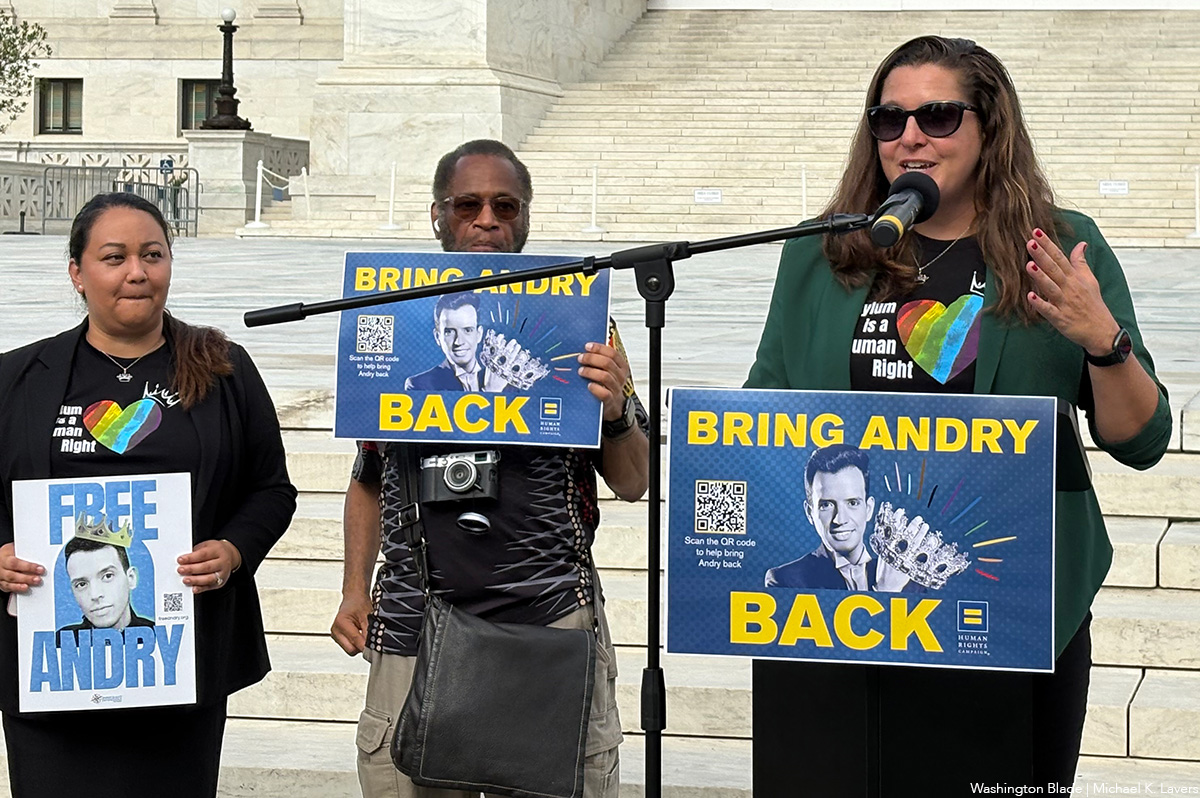
More than 200 people gathered in front of the U.S. Supreme Court on Friday and demanded the Trump-Vance administration return to the U.S. a gay Venezuelan asylum seeker who it “forcibly disappeared” to El Salvador.
Lindsay Toczylowski, president of the Immigrant Defenders Law Center, a Los Angeles-based organization that represents Andry Hernández Romero, is among those who spoke alongside U.S. Rep. Mark Takano (D-Calif.) and Human Rights Campaign Campaigns and Communications Vice President Jonathan Lovitz. Sarah Longwell of the Bulwark, Pod Save America’s Jon Lovett, and Tim Miller are among those who also participated in the rally.
“Andry is a son, a brother. He’s an actor, a makeup artist,” said Toczylowski. “He is a gay man who fled Venezuela because it was not safe for him to live there as his authentic self.”
(Video by Michael K. Lavers)
The White House on Feb. 20 designated Tren de Aragua, a Venezuelan gang, as an “international terrorist organization.”
President Donald Trump on March 15 invoked the Alien Enemies Act of 1798, which the Associated Press notes allows the U.S. to deport “noncitizens without any legal recourse.” The Trump-Vance administration subsequently “forcibly removed” Hernández and hundreds of other Venezuelans to El Salvador.
Toczylowski said she believes Hernández remains at El Salvador’s Terrorism Confinement Center, a maximum-security prison known by the Spanish acronym CECOT. Toczylowski also disputed claims that Hernández is a Tren de Aragua member.
“Andry fled persecution in Venezuela and came to the U.S. to seek protection. He has no criminal history. He is not a member of the Tren de Aragua gang. Yet because of his crown tattoos, we believe at this moment that he sits in a torture prison, a gulag, in El Salvador,” said Toczylowski. “I say we believe because we have not had any proof of life for him since the day he was put on a U.S. government-funded plane and forcibly disappeared to El Salvador.”
“Andry is not alone,” she added.
Takano noted the federal government sent his parents, grandparents, and other Japanese Americans to internment camps during World War II under the Alien Enemies Act. The gay California Democrat also described Hernández as “a political prisoner, denied basic rights under a law that should have stayed in the past.”
“He is not a case number,” said Takano. “He is a person.”
Hernández had been pursuing his asylum case while at the Otay Mesa Detention Center in San Diego.
A hearing had been scheduled to take place on May 30, but an immigration judge the day before dismissed his case. Immigrant Defenders Law Center has said it will appeal the decision to the Board of Immigration Appeals, which the Justice Department oversees.
“We will not stop fighting for Andry, and I know neither will you,” said Toczylowski.
Friday’s rally took place hours after Attorney General Pam Bondi said Kilmar Abrego Garcia, a Maryland man who the Trump-Vance administration wrongfully deported to El Salvador, had returned to the U.S. Abrego will face federal human trafficking charges in Tennessee.
National
A husband’s story: Michael Carroll reflects on life with Edmund White
Iconic author died this week; ‘no sunnier human in the world’
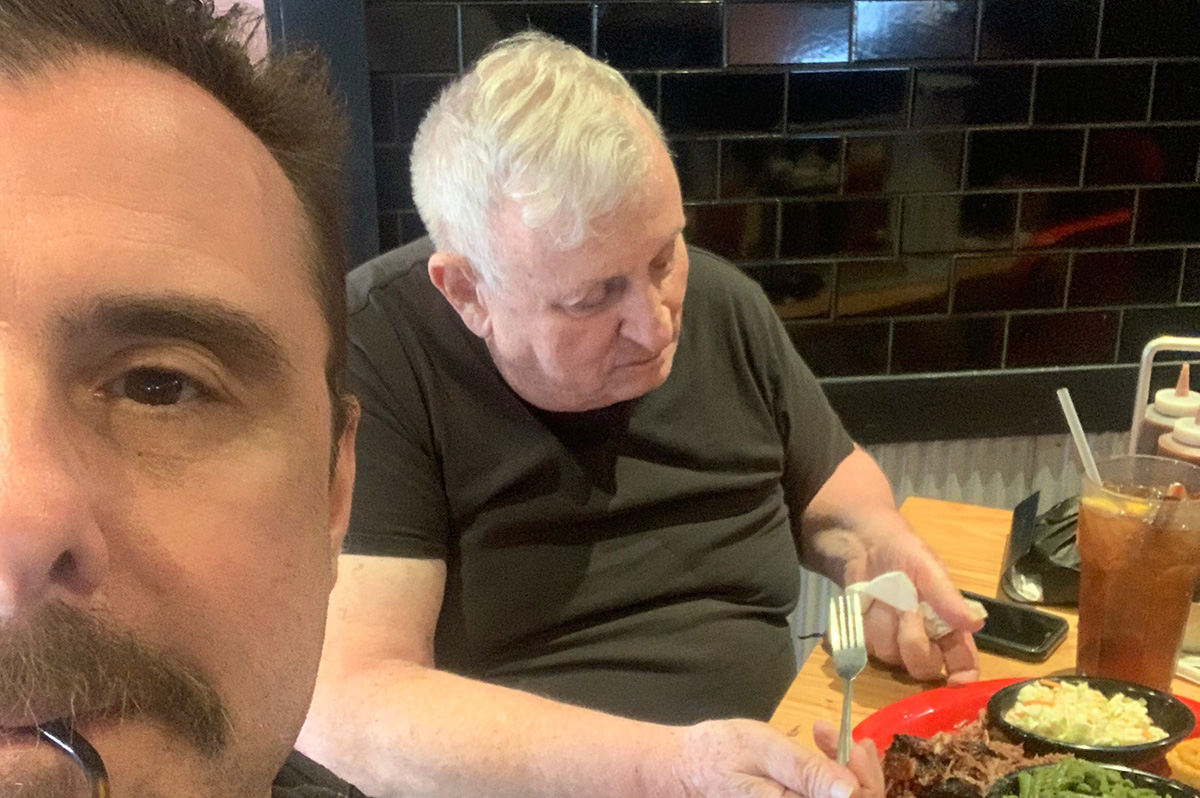
Unlike most gay men of my generation, I’ve only been to Fire Island twice. Even so, the memory of my first visit has never left me. The scenery was lovely, and the boys were sublime — but what stood out wasn’t the beach or the parties. It was a quiet afternoon spent sipping gin and tonics in a mid-century modern cottage tucked away from the sand and sun.
Despite Fire Island’s reputation for hedonism, our meeting was more accident than escapade. Michael Carroll — a Facebook friend I’d chatted with but never met — mentioned that he and his husband, Ed, would be there that weekend, too. We agreed to meet for a drink. On a whim, I checked his profile and froze. Ed was author Edmund White.
I packed a signed copy of Carroll’s “Little Reef” and a dog-eared hardback of “A Boy’s Own Story,” its spine nearly broken from rereads. I was excited to meet both men and talk about writing, even briefly.
Yesterday, I woke to the news that Ed had passed away. Ironically, my first thought was of Michael.
This week, tributes to Edmund White are everywhere — rightly celebrating his towering legacy as a novelist, essayist, and cultural icon. I’ve read all of his books, and I could never do justice to the scope of a career that defined and chronicled queer life for more than half a century. I’ll leave that to better-prepared journalists.
But in those many memorials, I’ve noticed something missing. When Michael Carroll is mentioned, it’s usually just a passing reference: “White’s partner of thirty years, twenty-five years his junior.” And yet, in the brief time I spent with this couple on Fire Island, it was clear to me that Michael was more than a footnote — he was Ed’s anchor, editor, companion, and champion. He was the one who knew his husband best.
They met in 1995 after Michael wrote Ed a fan letter to tell him he was coming to Paris. “He’d lost the great love of his life a year before,” Michael told me. “In one way, I filled a space. Understand, I worshiped this man and still do.”
When I asked whether there was a version of Ed only he knew, Michael answered without hesitation: “No sunnier human in the world, obvious to us and to people who’ve only just or never met him. No dark side. Psychology had helped erase that, I think, or buffed it smooth.”
Despite the age difference and divergent career arcs, their relationship was intellectually and emotionally symbiotic. “He made me want to be elegant and brainy; I didn’t quite reach that, so it led me to a slightly pastel minimalism,” Michael said. “He made me question my received ideas. He set me free to have sex with whoever I wanted. He vouchsafed my moods when they didn’t wobble off axis. Ultimately, I encouraged him to write more minimalistically, keep up the emotional complexity, and sleep with anyone he wanted to — partly because I wanted to do that too.”
Fully open, it was a committed relationship that defied conventional categories. Ed once described it as “probably like an 18th-century marriage in France.” Michael elaborated: “It means marriage with strong emotion — or at least a tolerance for one another — but no sex; sex with others. I think.”
That freedom, though, was always anchored in deep devotion and care — and a mutual understanding that went far beyond art, philosophy, or sex. “He believed in freedom and desire,” Michael said, “and the two’s relationship.”
When I asked what all the essays and articles hadn’t yet captured, Michael paused. “Maybe that his writing was tightly knotted, but that his true personality was vulnerable, and that he had the defense mechanisms of cheer and optimism to conceal that vulnerability. But it was in his eyes.”
The moment that captured who Ed was to him came at the end. “When he was dying, his second-to-last sentence (garbled then repeated) was, ‘Don’t forget to pay Merci,’ the cleaning lady coming the next day. We had had a rough day, and I was popping off like a coach or dad about getting angry at his weakness and pushing through it. He took it almost like a pack mule.”
Edmund White’s work shaped generations — it gave us language for desire, shame, wit, and liberation. But what lingers just as powerfully is the extraordinary life Ed lived with a man who saw him not only as a literary giant but as a real person: sunny, complex, vulnerable, generous.
In the end, Ed’s final words to his husband weren’t about his books or his legacy. They were about care, decency, and love. “You’re good,” he told Michael—a benediction, a farewell, maybe even a thank-you.
And now, as the world celebrates the prolific writer and cultural icon Edmund White, it feels just as important to remember the man and the person who knew him best. Not just the story but the characters who stayed to see it through to the end.
-

 World Pride 20252 days ago
World Pride 20252 days agoWorldPride recap: Festival, parade, fireworks, and Doechii
-
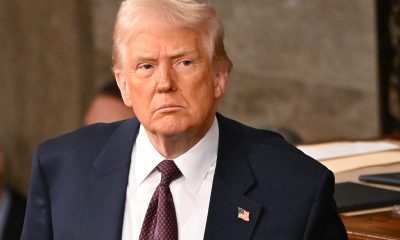
 U.S. Federal Courts2 days ago
U.S. Federal Courts2 days agoJudge temporarily blocks executive orders targeting LGBTQ, HIV groups
-

 Photos2 days ago
Photos2 days agoPHOTOS: WorldPride Parade
-

 Photos2 days ago
Photos2 days agoPHOTOS: WorldPride Street Festival and Closing Concert



